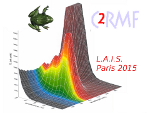Nowadays, methodological and instrumental advances in luminescence dating gained during the last two decades allow for precise and reliable age estimates up to ca. 250 ka. Even more, recent developments made in the field of optically stimulated luminescence (OSL) dating may demand for a re-investigation of sites examined using thermally stimulated (TL) or infrared stimulated luminescence (IRSL) dating to enhance and prove the previously obtained dating results.
Here, for the first time, we present OSL dating results for the Mousterian sequence La Combette using the fine grain (4–11 µm) quartz and polymineral fraction. The section is located in the Luberon mountain in the south-east of Avignon (France) and is known for its five well-preserved archaeological layers (A to F/G) over ca. 7 m of sediment indicating a late Mousterian occupation (Texier et al., 2003; Texier, 2004). The section has been detailed investigated between 1986 and 2003 using a multidisciplinary approach. Based on IRSL and TL measurements the chronological framework of the section was originally settled between 45 ka and 75 ka (Texier et al., 2003)
In summer 2014 the section was re-investigated for OSL dating using the quartz fine grain fraction. In contrast to (a) TL dating an age overestimation due to insufficient bleaching during transport of the investigated signal is not expected and (b) contrary to feldspars previously dated by IRSL the mineral quartz is not known to suffer from anomalous fading causing age underestimation. Furthermore, in loess environments the fine grain quartz fraction was proved to result in reliable age estimates up to ca. 120 ka (Kreutzer, et al., 2012; Fuchs et al. 2013).
Samples were taken from the loess dominated upper levels A to D (upper main unit) from the fluvial level F/G and the heavily disturbed gravel and block enriched layer E (both lower main unit). With our contribution the new dating results are presented along with a critical discussion on the implication for the interpretation of the occupation history of this important archaeological site.
References:
Fuchs, M., Kreutzer, S., Rousseau, D.D., Antoine, P., Hatté, C., Lagroix, F., Moine, O., Gauthier, C., Svoboda, J., Lisá, L., (2013) The loess sequence of Dolní Věstonice, Czech Republic: A new OSL‐based chronology of the Last Climatic Cycle. Boreas, 42, 664-677.
Kreutzer, S., Fuchs, M., Meszner, S., Faust, D. (2012). OSL chronostratigraphy of a loess-palaeosol sequence in Saxony/Germany using quartz of different grain sizes. Quaternary Geochronology, 10, 102-109.
Texier, P.-J., Brugal, J.-P., Desclaux, E., Lemorini, C., Sáez, J.A.L., Thery, I., Wilson, L. (2003). La Combette (Bonnieux, Vaucluse, France): a Mousterian sequence in the Luberon mountain chain, between the plains of the Durance and Calavon rivers. Preistoria Alpina, 39, 77-90.
Texier, P.-J. (2004). Le paléolithique moyen de la montagne du Luberon au mont Ventoux. In: Vaucluse préhistorique, J., Buisson-Catil, A., Guilcher, C., Hussy, M., Olove, M., Pagny, eds, 61-84.
- Poster

 PDF version
PDF version

